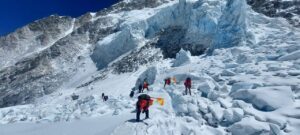The big debate in the climbing community around K2 this winter is not so much about the crowding, the commercialization, or the perils lying ahead for relatively inexperienced mountaineers. It’s about the use of O2.
Most leading climbers have avoided overtly criticizing the style of the current expeditions. Everyone from Simone Moro to Denis Urubko cites the usual diplomacy about everyone’s right to climb a mountain however they see fit. Instead, they express a wish rather than a criticism: They hope that the first winter ascent of K2 will happen without supplementary O2.
Adam Bielecki has been blunt about the use of bottled oxygen: “Oxygen climbing the 8,000’ers is like doing the Tour de France on an electric bike,” he tweeted recently. “The nature of the feat is completely different.”

Jon Griffith. Photo: Jon Griffith
Chamonix-based mountain photographer Jon Griffith agrees. He wrote on FaceBook recently: “It’s 2020, and if you want to claim the prize, you should be adhering to modern ethics and styles. The whole point of these high peaks is the lack of oxygen.”
“You may find that you can’t play football with Messi or tennis against Nadal,” Romanian climber Minhea Radulescu wrote. “Your weakness is not an excuse for using O2: If you want to climb big mountains, get yourself to the height of the mountain, don’t bring the mountain down to your level.”
“I would find it a real pity if someone steals the first winter ascent of K2 by using supplemental oxygen,” concluded Ralf Dujmovits, who has been on K2 five times, including a no-O2 summit and three attempts that ended above 8,000m, all without supplementary oxygen. “The general public might see this ‘conquering’ of K2 as a great feat, but the first winter ascent should be left to those who can do it…in style.”
Dujmovits does give a chance to some climbers currently on the mountain: “My hope is that one or more of them will stand on top before someone with an oxygen bottle does,” he said.
That should be the end of this article. But there is another uncomfortable question which, although not new, has exploded this winter because of the attention on K2 as a potential world first.

K2 Base Camp. Photo: Waldemar Kowalewski
It involves all the expeditions currently in Base Camp: Should a climber’s successful ascent be counted as no-O2 if it relies on ropes previously fixed by a team of Sherpas on oxygen?
From an arbiter’s point of view, the answer is yes. Both 8000ers.com and the Himalayan Database credit no-O2 climbs based on an individual summiter’s gear during both ascent and descent, not on who preceded them or how. At the same time, purists may argue that a no-O2 climber would never get to the upper slopes of K2 in winter, if not for the previous work of those on gas.
Kilian Jornet said recently on Instagram: “If someone in the team is carrying O2, the exposure disappears since if the non-O2 climber has a problem, he/she has immediate access to O2.
In this sense, what really makes all the difference is not just the use of oxygen, but its availability. Years ago, ExplorersWeb founder Tom Sjögren spoke of “psychological O2” — how if O2 is available in a higher camp or a cache, a climber will take more risks and go higher than if that potentially life-saving resource were not available.
Jon Griffith recalls his experience on Everest and the difference oxygen makes:
“I’ve used O2 on Everest and I could not believe the difference it made. I went from feeling like I was at 7,500m (cold, bit weak, lightheaded) to feeling like I was running around in the Alps in summer. It’s not just the additional fuel it gives your muscles. It’s the cognitive ability and the warmth it also gives. It’s an amazing feedback circle. I think people massively underestimate the difference O2 makes, I certainly did. It’s also not just about pushing yourself physically further. It’s also about knowing when to turn around — on O2, it doesn’t matter, you just turn around. But without O2, you are on a ticking timer: You need to know when to turn around in order to get back down low enough before your body and brain shut down on you. Without the cognitive help that O2 gives, it is very very hard to know when that turnaround time is. The commitment to climbing without O2 is next level. I took my mask off on the summit of Everest to set up a camera and pretty soon I started to feel like sh*t. I remembered thinking to myself, if I started to run down the fixed ropes now, would I make it down low enough?…Remove [the O2] and it’s not the same thing at all.”
The current debate centres partly on the search for purity in climbing but also respect toward previous no-O2 winter firsts on other 8,000’ers. Winter K2 not just a climb but a coveted first that has previously defeated the best climbers in the world.
At the same time, even with O2 and fixed ropes, K2 is far from easy, especially at this time of year. As Sergi Mingote said recently, only a few climbers will be in condition for a summit push, and even if they only reach 8,000m, he would consider that a great success. Ralf Dujmovits admits that he has never even considered attempting K2 in winter. And if K2 is summited this season in a less-than-perfect style, the ultimate challenge — redoing it without O2 — will remain for future trail breakers.






